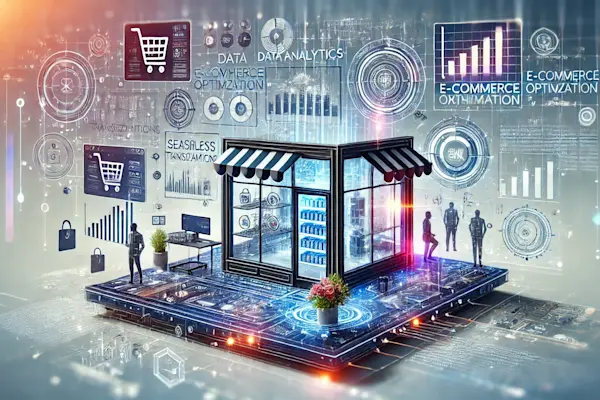
Point of Sale (POS) Software
Published on: February 13, 2025
Overview
Definition
Point of Sale (POS) software is a critical system that enables businesses to process sales transactions, manage inventory, and integrate with payment solutions. Modern POS solutions go beyond just payment processing, offering tools for customer relationship management (CRM), sales analytics, employee management, and omnichannel retailing.
Who Uses It?
Retail Stores – Managing transactions, tracking sales, and handling promotions.
Restaurants & Cafés – Order processing, menu management, and tipping.
E-commerce Businesses – Integrated online and in-store payments.
Service Providers – Booking and invoicing services.
Hospitality Industry – Hotels and event venues for managing guest purchases.
Why It Matters
Enhances Efficiency – Automates transactions, inventory tracking, and reporting.
Improves Customer Experience – Enables loyalty programs and seamless payments.
Increases Sales & Revenue – Supports omnichannel selling and analytics-driven marketing
2. Key Features to Consider
Must-Have Features
Inventory Management – Real-time stock tracking and automated restocking alerts.
Payment Processing – Secure transactions with multiple payment methods.
Sales Reporting & Analytics – Insights into revenue, trends, and performance.
User Permissions & Employee Management – Role-based access and shift tracking.
Customer Relationship Management (CRM) – Loyalty programs and personalized offers.
Advanced Features
Omnichannel Sales Support – Seamless integration between online and physical stores.
AI-Powered Insights – Forecast sales trends and optimize pricing strategies.
Mobile POS & Cloud Access – Enable transactions anywhere via mobile devices.
Third-Party Integrations – Accounting, e-commerce, and marketing tools.
Self-Checkout & Contactless Payment – Faster transactions and reduced labor costs.
Customization & Integrations
Industry-Specific Configurations – Tailored for retail, restaurants, and hospitality.
API & Plugin Support – Extends POS capabilities with add-ons.
Scalability – Adapts to business growth with multi-location support.
3. Types of POS Software and Top Solutions
3.1 Retail POS Solutions
| Software | Key Features | G2 Score | Capterra Score | SoftwareAdvice Score | TrustRadius Score | Average Score | Pricing | Website |
|---|---|---|---|---|---|---|---|---|
Square POS | Omnichannel sales, inventory tracking | 4.7 | 4.6 | 4.5 | 4.6 | 4.6 | Starts at $0/month | |
Shopify POS | E-commerce integration, mobile checkout | 4.6 | 4.5 | 4.4 | 4.5 | 4.5 | Starts at $29/month | |
Lightspeed Retail | Advanced analytics, multi-location | 4.5 | 4.4 | 4.3 | 4.4 | 4.4 | Starts at $69/month | |
Clover POS | Customizable hardware, payment flexibility | 4.5 | 4.3 | 4.2 | 4.3 | 4.3 | Custom | |
Revel Systems | Cloud-based, robust reporting tools | 4.4 | 4.2 | 4.1 | 4.3 | 4.3 | Custom |
3.2 Restaurant POS Solutions
| Software | Key Features | G2 Score | Capterra Score | SoftwareAdvice Score | TrustRadius Score | Average Score | Pricing | Website |
|---|---|---|---|---|---|---|---|---|
Toast POS | Restaurant-specific, tableside ordering | 4.7 | 4.6 | 4.5 | 4.6 | 4.6 | Custom | Visit Site |
Square for Restaurants | Flexible pricing, menu customization | 4.6 | 4.5 | 4.4 | 4.5 | 4.5 | Starts at $60/month | Visit Site |
Lightspeed Restaurant | Multi-location support, advanced analytics | 4.5 | 4.4 | 4.3 | 4.4 | 4.4 | Starts at $59/month | Visit Site |
Clover Dining POS | Customizable for full-service restaurants | 4.4 | 4.3 | 4.2 | 4.3 | 4.3 | Custom | Visit Site |
Revel Restaurant POS | Cloud-based, integrated kitchen management | 4.3 | 4.2 | 4.1 | 4.3 | 4.3 | Custom | Visit Site |
3.3 E-commerce POS Solutions
| Software | Key Features | G2 Score | Capterra Score | SoftwareAdvice Score | TrustRadius Score | Average Score | Pricing | Website |
|---|---|---|---|---|---|---|---|---|
Shopify POS | Seamless e-commerce integration | 4.7 | 4.6 | 4.5 | 4.6 | 4.6 | Starts at $29/month | |
Square for Retail | Advanced inventory, unified payments | 4.6 | 4.5 | 4.4 | 4.5 | 4.5 | Starts at $0/month | Visit Site |
Lightspeed eCom | Customizable storefront, robust analytics | 4.5 | 4.4 | 4.3 | 4.4 | 4.4 | Starts at $69/month | Visit Site |
WooCommerce POS | WordPress integration, self-hosted control | 4.4 | 4.3 | 4.2 | 4.3 | 4.3 | Custom | Visit Site |
BigCommerce POS | Omnichannel retail support | 4.3 | 4.2 | 4.1 | 4.3 | 4.3 | Custom |
3.4 Service Industry POS Solutions
| Software | Key Features | G2 Score | Capterra Score | SoftwareAdvice Score | TrustRadius Score | Average Score | Pricing | Website |
|---|---|---|---|---|---|---|---|---|
Mindbody POS | Appointment booking, CRM integration | 4.7 | 4.6 | 4.5 | 4.6 | 4.6 | Custom | |
Fresha POS | Free software for salons, easy scheduling | 4.6 | 4.5 | 4.4 | 4.5 | 4.5 | Free | |
Booker POS | Spa and salon management, loyalty tracking | 4.5 | 4.4 | 4.3 | 4.4 | 4.4 | Starts at $129/month | |
Square for Appointments | Integrated payments, calendar sync | 4.4 | 4.3 | 4.2 | 4.3 | 4.3 | Starts at $0/month | Visit Site |
Zenoti POS | Enterprise wellness and fitness industry focus | 4.3 | 4.2 | 4.1 | 4.3 | 4.3 | Custom |
Special Mentions
Korona POS
Korona POS is a cloud-based retail POS solution that caters to small and mid-sized businesses. It provides robust inventory management, detailed sales reporting, and industry-specific features for retail, liquor stores, and ticketing businesses.
ResyOS
ResyOS is a powerful restaurant POS system designed to streamline front-of-house operations. It offers reservation management, guest insights, and integration with leading payment solutions for restaurants aiming to optimize table turnover and customer experience.
ShopHunter
ShopHunter is a specialized e-commerce and retail analytics platform that helps businesses track competitive pricing, customer behavior, and inventory insights. Its focus on data-driven decision-making makes it an essential tool for online and physical retailers.
MRPeasy
MRPeasy is an ERP and manufacturing-focused POS software tailored for small and medium-sized enterprises. It offers production planning, supply chain management, and real-time inventory tracking to help manufacturers streamline operations.
4. Pricing Models & Cost Considerations
Common Pricing Structures
Subscription-Based – Monthly or annual fees covering software, updates, and support.
One-Time License Fees – Upfront payment for perpetual use.
Transaction-Based Pricing – Fees per transaction processed (common in payment-integrated POS systems).
Custom Enterprise Pricing – Tailored pricing for large-scale implementations.
Hidden Costs
Hardware Costs – Terminals, barcode scanners, and printers.
Setup & Implementation Fees – One-time installation and training fees.
Third-Party Integrations – Additional charges for API access and add-ons.
Support & Maintenance – Extended warranties and priority support fees.
Negotiation Tips
Bundle Hardware & Software – Some vendors offer discounts on full packages.
Look for Free Trials – Test usability before committing.
Ask About Processing Fees – Understand transaction costs upfront.
Negotiate Long-Term Contracts – Multi-year agreements often come with discounts.
5. How to Choose the Right POS Software
Step-by-Step Buyer’s Checklist
✅ Define operational needs and must-have features. ✅ Compare pricing models and hidden costs. ✅ Evaluate user reviews and customer support reputation. ✅ Request demos and free trials. ✅ Assess scalability for future business growth. ✅ Verify security compliance and fraud protection measures.
Common Mistakes to Avoid
Ignoring Total Cost of Ownership – Be mindful of ongoing fees.
Choosing the Wrong Industry Fit – Ensure the POS system aligns with your business type.
Not Checking Compatibility – Verify integrations with existing tools.
Skipping Employee Training – Proper onboarding ensures smooth operations.
Decision Matrix Template
| Factor | Weight | Option 1 | Option 2 | Option 3 |
|---|---|---|---|---|
Features & Functionality | X% | Score | Score | Score |
Pricing & Total Cost | X% | Score | Score | Score |
Integration Capabilities | X% | Score | Score | Score |
Ease of Use | X% | Score | Score | Score |
Vendor Support & Reputation | X% | Score | Score | Score |
Total Score | 100% | Score | Score | Score |
6. Implementation & Adoption Tips
Best Practices for Rolling Out New POS Software
Test with a Pilot Location – Ensure smooth deployment before scaling.
Integrate with Existing Systems – Sync with inventory, CRM, and accounting tools.
Train Staff Properly – Provide hands-on training and reference guides.
Monitor & Optimize Usage – Use analytics to refine sales and inventory strategies.
How to Get Team Buy-In
Highlight Efficiency Gains – Demonstrate how the software reduces workload.
Offer Hands-On Training – Ease adoption through practical usage sessions.
Address Security & Compliance – Reassure employees about data safety.
Ongoing Maintenance & Optimization
Regular Software Updates – Stay updated with the latest features and security patches.
Analyze Sales Reports – Optimize product offerings based on performance trends.
Ensure Compliance with Regulations – Adhere to financial and tax reporting requirements.
7. Conclusion & Next Steps
Choosing the right POS software is crucial for streamlining operations and enhancing customer experience. By understanding industry-specific needs and evaluating top solutions, businesses can maximize efficiency and profitability.
For personalized POS recommendations and consultations, contact us at connect@allcaps.ai.


